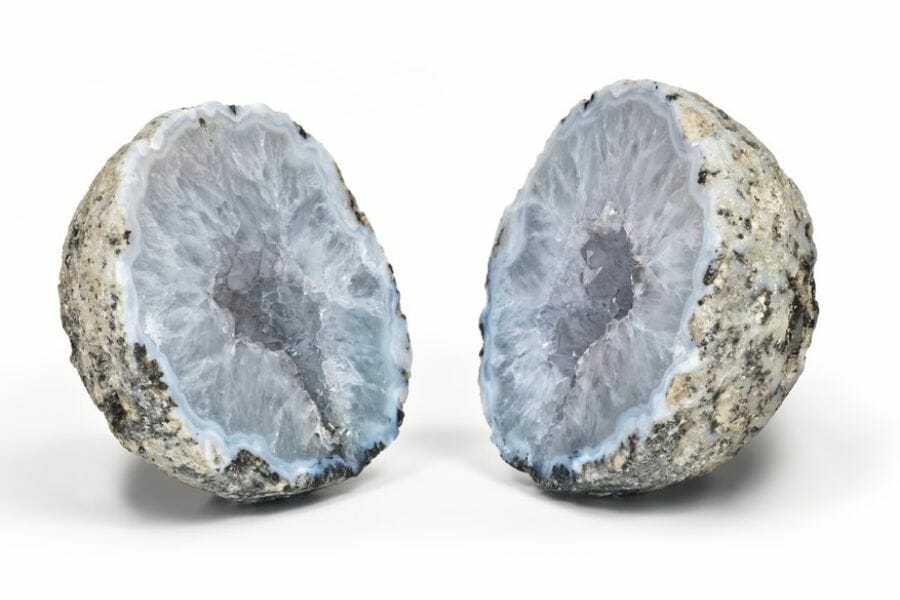Geodes are like nature’s surprise eggs, filled with sparkling crystals inside a plain-looking rock. Our state is a treasure trove for these hidden gems, with its many different landscapes that make it perfect for rock hounds.
If you’re itching to crack open your own crystal-filled wonder, you’re in the right place!
This article will show you the best spots in our state to find geodes. We’ll also share some handy tips to make your geode hunting adventure a success.
So grab your hammer and get ready to discover the beauty hiding in ordinary-looking rocks all around this state!
How Geodes From Here
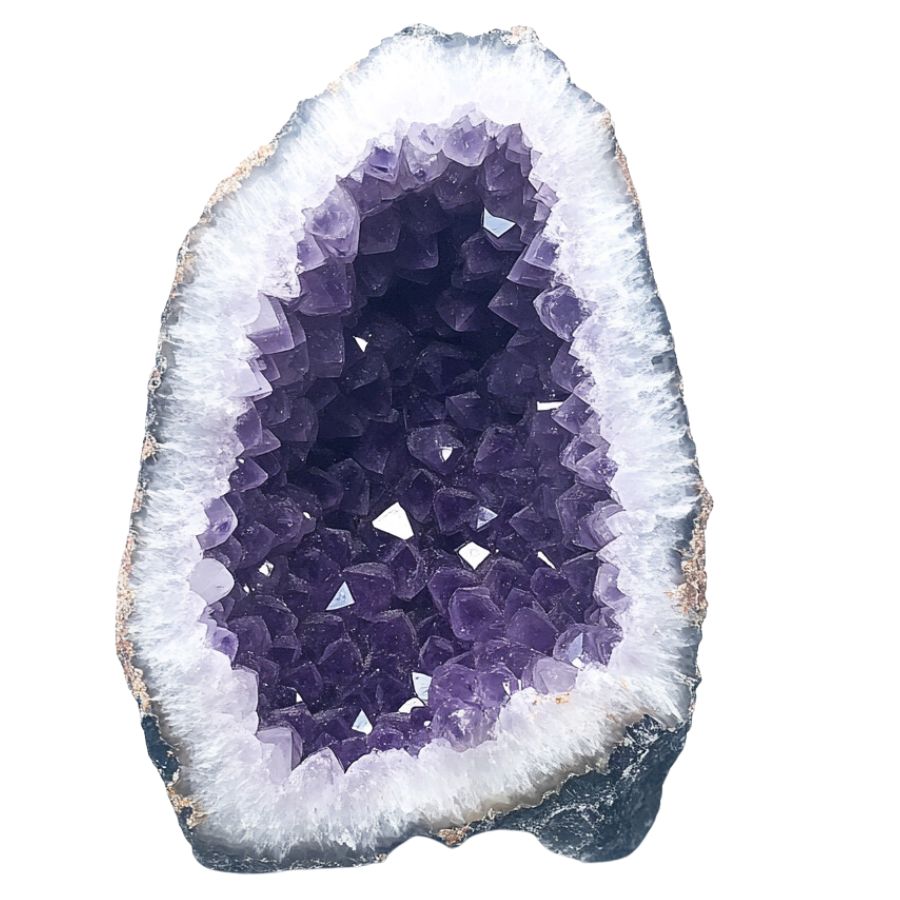
Geodes form when bubbles in volcanic rocks or spaces in sedimentary rocks get filled with minerals over time.
First, water rich in minerals like quartz or calcite seeps into the hollow space. As the water evaporates, it leaves behind the minerals, which slowly build up layer by layer.
Eventually, these minerals create a crystal lining inside the geode. The outer shell stays rough, while the inside becomes a sparkling treasure.
The process can take thousands, even millions, of years, making each geode a unique and beautiful time capsule of Earth’s natural forces.
The Types Of Geodes Found in the US
There are many fascinating varieties of geodes that can be found across the United States, including in our own state. Each type is distinctly beautiful and intriguing:
Amethyst Geode
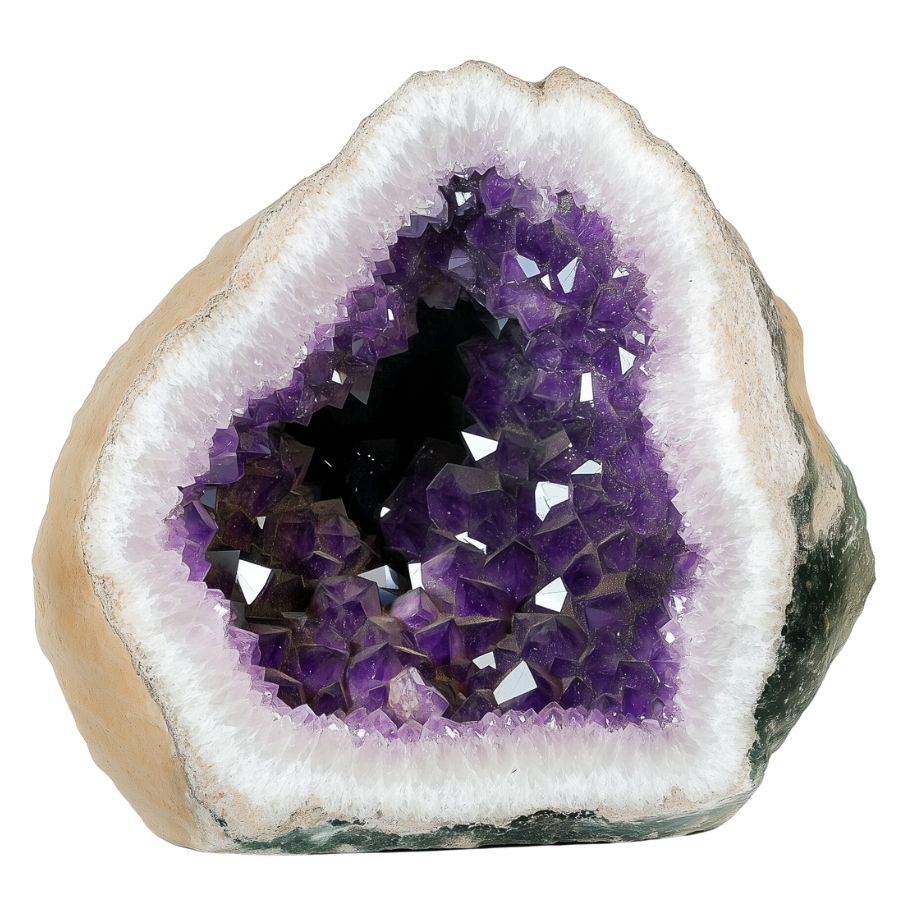
Amethyst geodes look plain on the outside, like a potato. But crack them open, and you’ll find stunning purple crystals. These crystals can be light lavender or deep purple.
The structure of crystals inside can vary widely. Some are tiny and densely packed, creating a sparkling surface. Others form large, distinct points that jut inwards.
The color range is impressive too, from pale lilac to deep royal purple. Some amethyst geodes develop unique features. “Stalactites” of amethyst might hang from the top.
In rare cases, you might find a water bubble trapped inside, a remnant from the geode’s formation millions of years ago.
Citrine Geode
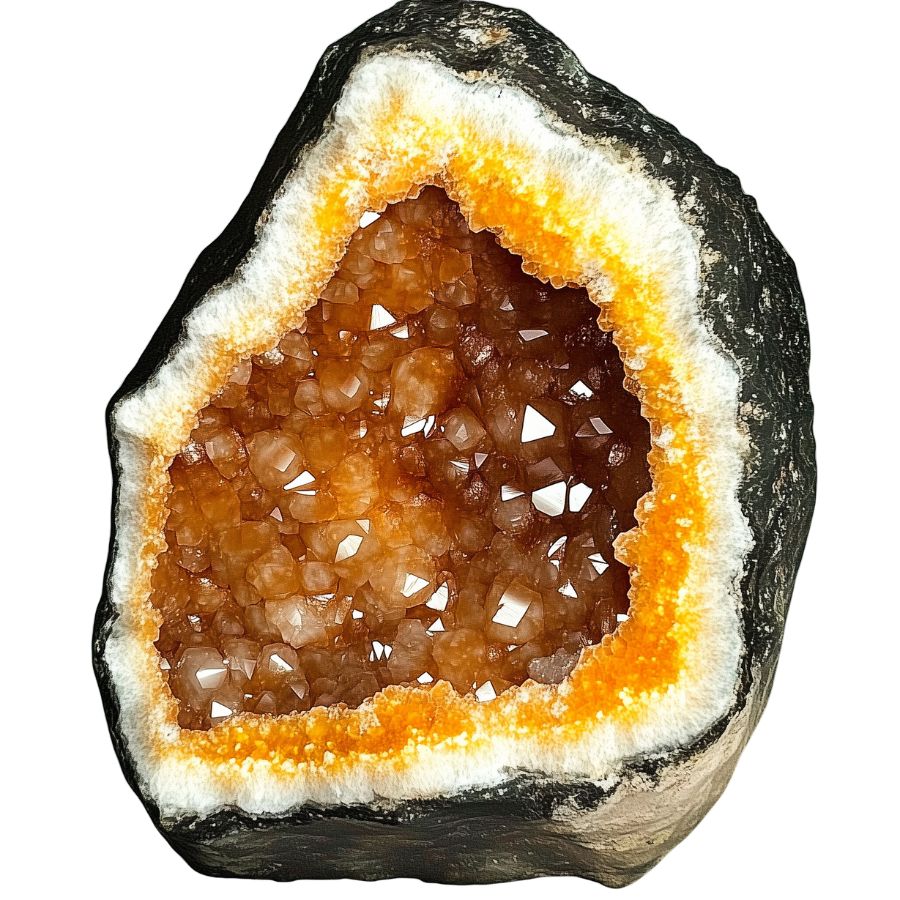
Citrine geodes are eye-catching rocks with golden yellow to orange crystals inside. They sparkle when light hits them, looking like sunshine trapped in stone. The colors come from iron mixed in with the quartz.
Unlike many gemstones, citrine’s color is often evenly distributed throughout the crystal.
Most citrine on the market isn’t natural. It’s actually heat-treated amethyst. This process turns the purple amethyst into vibrant citrine. Natural citrine is rarer and often has a more subtle color.
Pyrite Geode
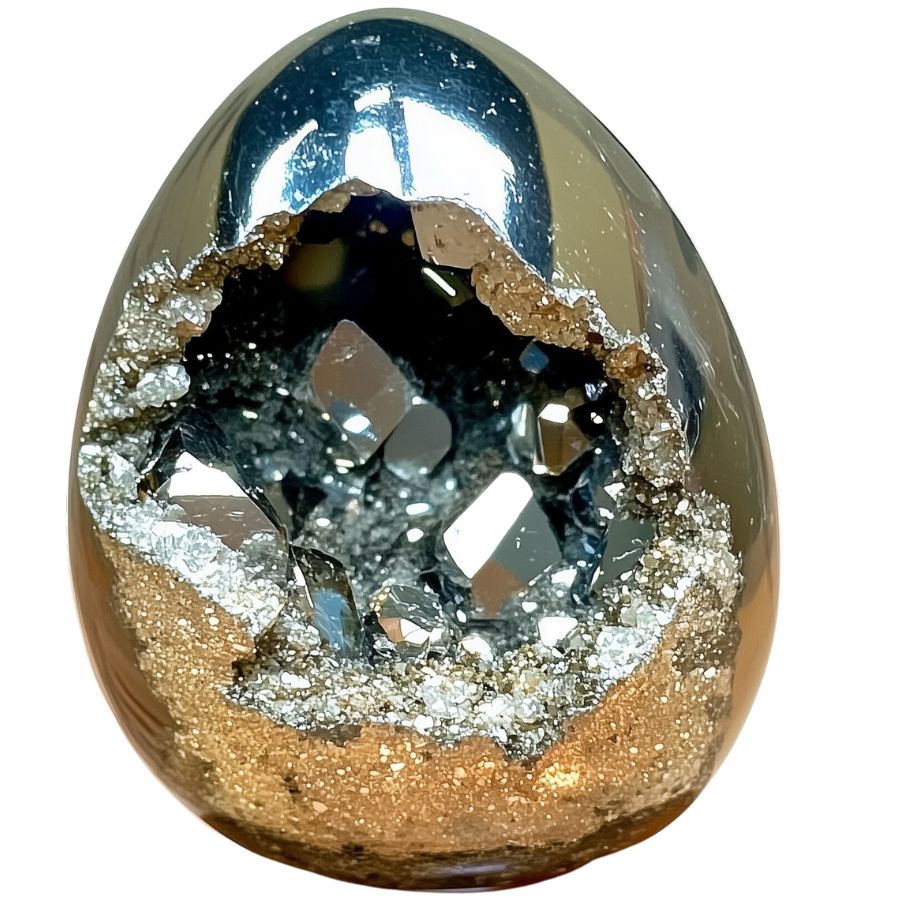
Ever cracked open a rock and found gold inside? Well, not real gold, but something that looks just like it. That’s a pyrite geode. Pyrite is called “fool’s gold” because it’s so shiny and golden.
Inside these geodes, pyrite forms in cool shapes. Sometimes it’s perfect cubes. Other times its clumps or even round balls called “pyrite suns”.
Pyrite has a fun history. People have been mixing it up with real gold for thousands of years. That’s how it got its nickname.
Selenite Geode
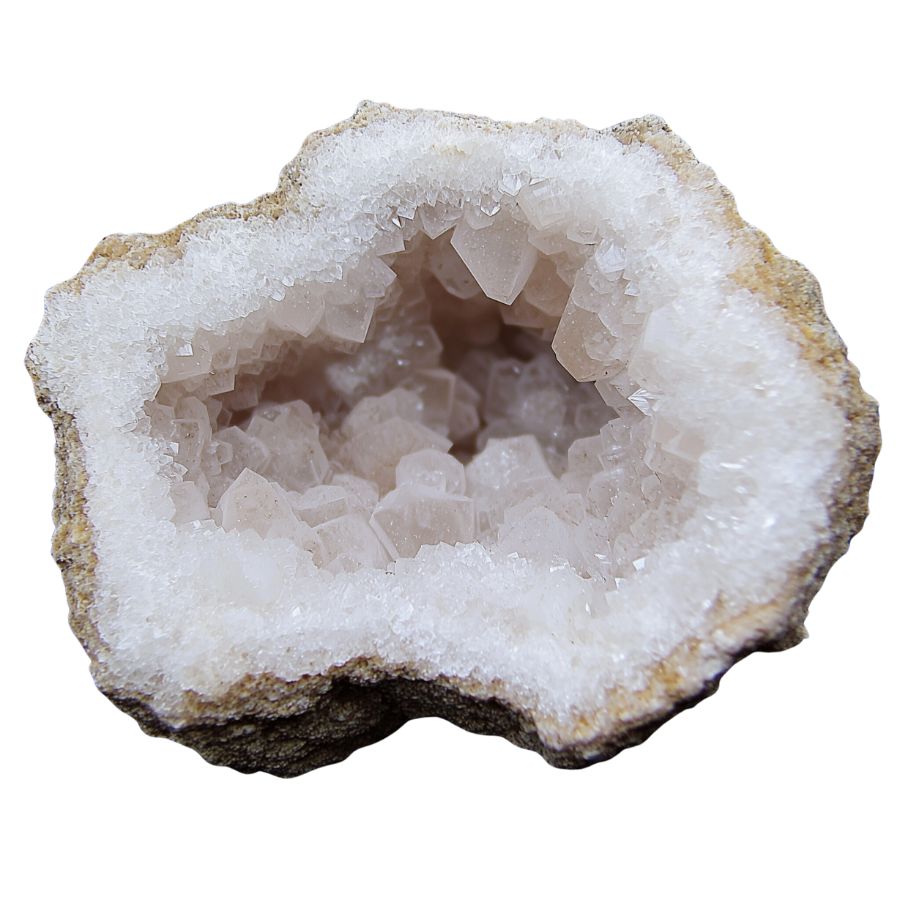
Selenite geodes stand out from the crowd. They’re white and see-through, with a glassy look. When you open one up, you’ll see crystals that look like they’re made of ice or moonlight.
Unlike harder geodes, selenite is soft. You can scratch it with your fingernail! This softness means you need to handle it carefully. But it also means selenite can be shaped into beautiful forms easily.
One cool thing about selenite is how it plays with light. Hold it up to a lamp, and you’ll see the light shine right through it. This makes selenite geodes popular for decorative lamps and light fixtures. They add a magical glow to any room.
Celestite Geode
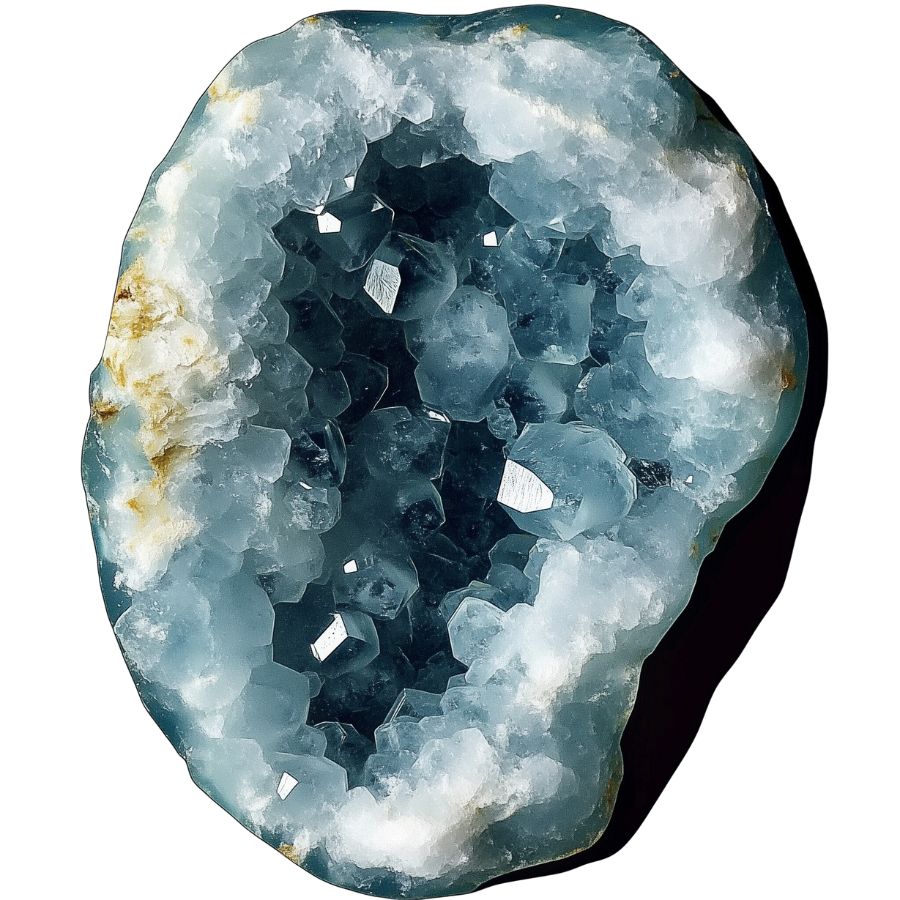
Celestite geodes are like pieces of sky trapped in rock. Their crystals are typically a delicate blue, ranging from almost colorless to deep sky blue. In rare cases, celestite can form in other colors. Pink celestite is highly prized by collectors.
One unique feature of celestite is its perfect cleavage. This means the crystals can be easily split into rhombohedral shapes.
These geodes form in a unique way. They start as nodules of a soft mineral called alabaster. Over time, this dissolves and is replaced by celestite crystals. Some celestite geodes are huge, like the famous Crystal Cave in Ohio.
Celestite isn’t just pretty to look at. It’s used to make strontium, an element with many uses. You’ll find strontium in fireworks, where it creates red colors. It’s also used in making TV screens and ceramics.
Jasper Geode
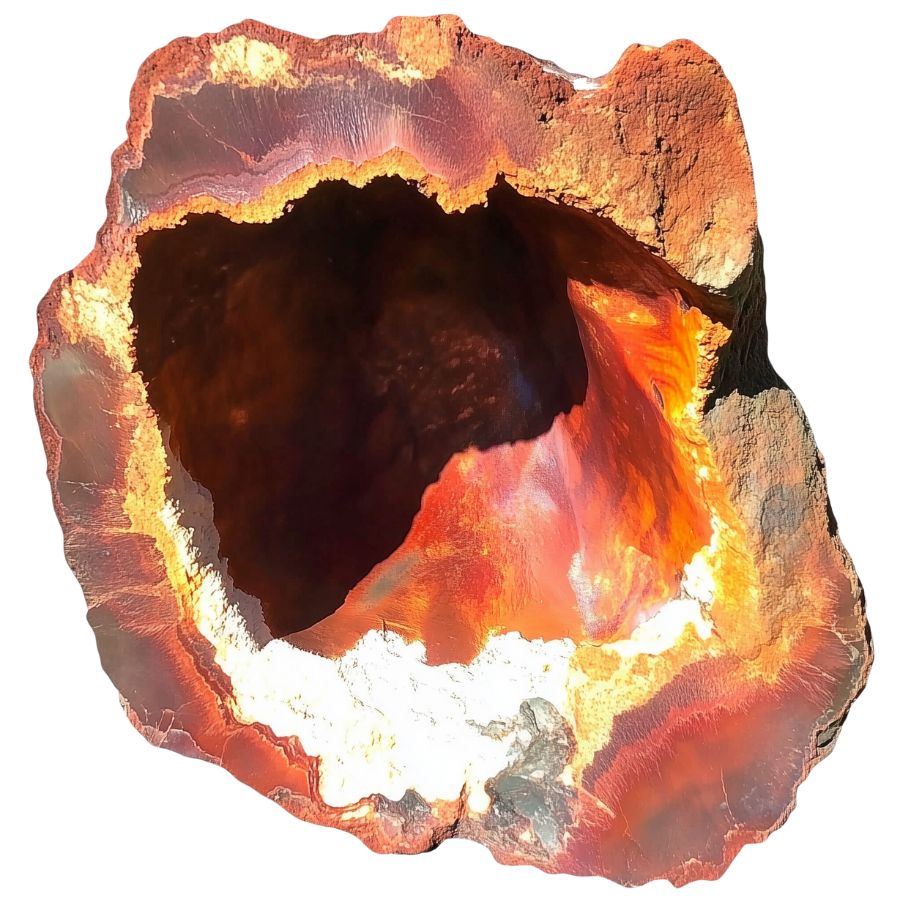
Jasper geodes are the chameleons of the mineral world. They can appear in almost any color, often with multiple hues in a single specimen. Patterns can range from solid colors to intricate swirls, bands, or spots.
One fascinating type is picture jasper. These geodes contain patterns that resemble landscapes, with “skies,” “mountains,” and “rivers” visible in the stone. Each one is like a miniature painting created by nature.
Some jasper geodes contain orbicular patterns – spherical structures that formed as the jasper solidified. These create eye-catching bull’s-eye or flower-like designs in the stone, making each piece truly one-of-a-kind.
Carnelian Geode
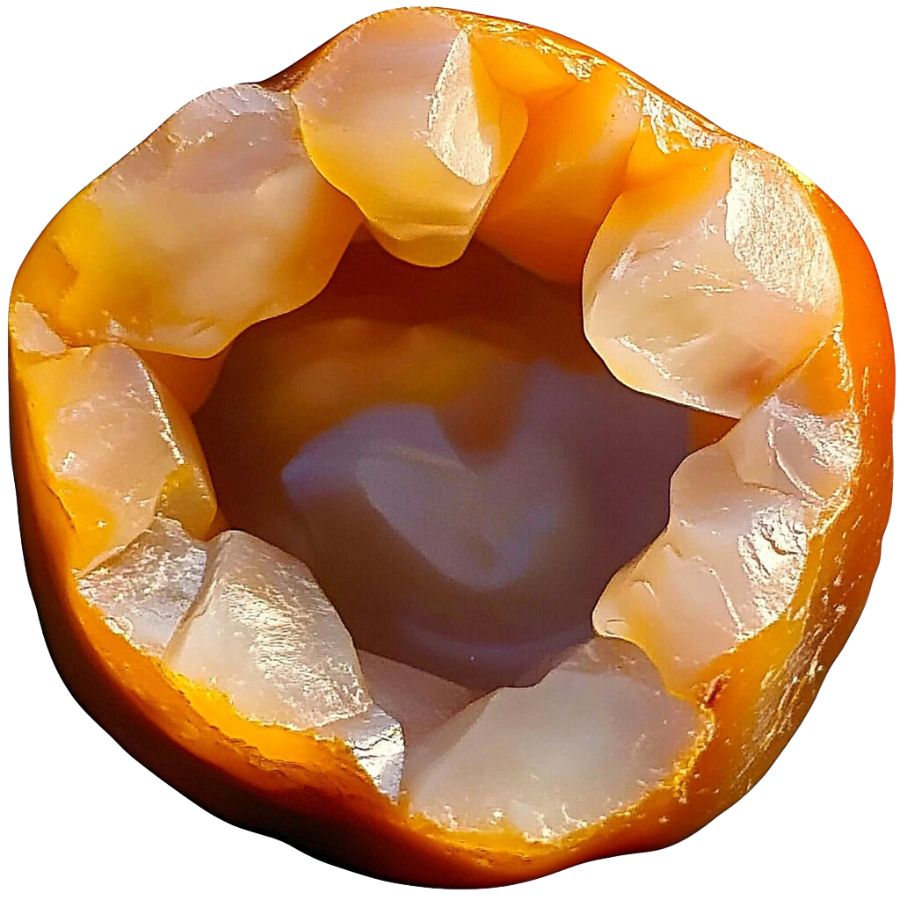
Carnelian geodes have vibrant orange to reddish-brown colors. They can be somewhat see-through, which makes them look even more interesting. The bright colors come from the iron in the stone.
These geodes stand out from other similar stones. They’re brighter than sard, which is usually darker and more brownish. And unlike agate, carnelian doesn’t have bands or stripes.
Carnelian has been popular for a long time. Ancient Egyptians and Greeks used it to make special rings. It’s tough enough for everyday jewelry.
Some people heat or dye carnelian to make its color even brighter. This makes it a favorite for both rock collectors and jewelry lovers.
Fluorite Geode
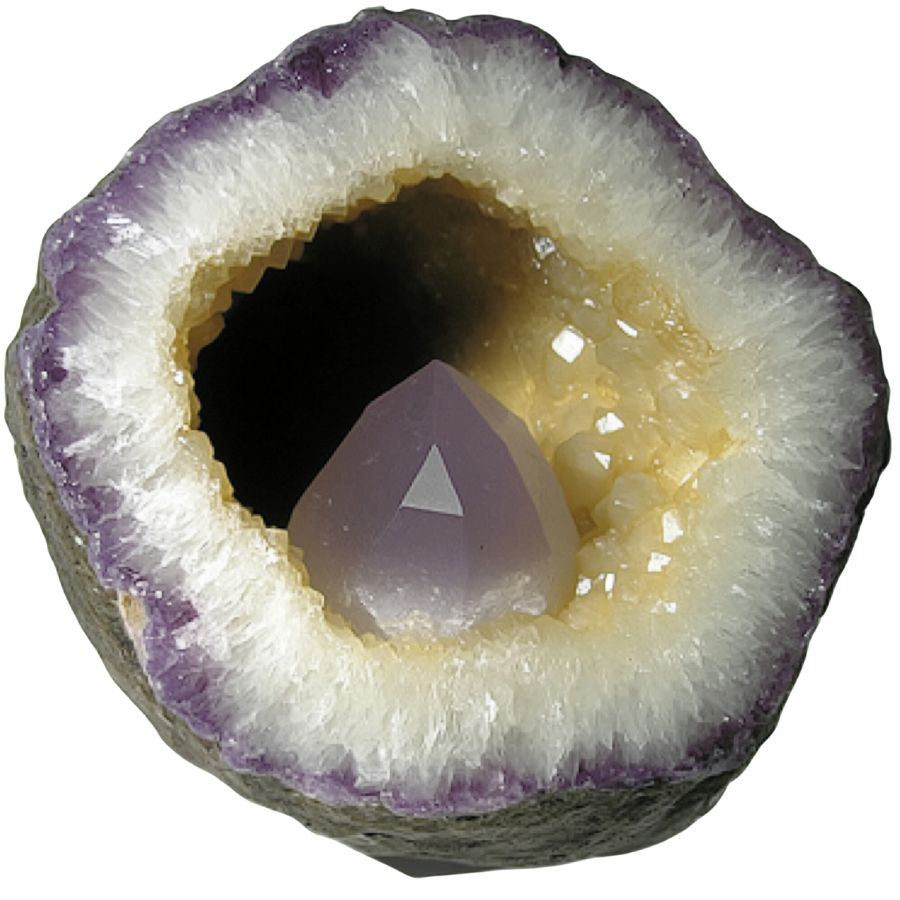
Fluorite geodes are like nature’s rainbow. They come in many colors – purple, green, blue, yellow, and sometimes even clear or black. When you open one up, you might see cube-shaped or eight-sided crystals inside.
What makes fluorite special is that you can often see more than one color in a single stone. This is different from many other geodes. Also, fluorite has a unique way of splitting when it breaks.
A cool fact: fluorite glows blue under ultraviolet light. This was first discovered back in 1852. Because of its many colors and this glowing ability, fluorite is sometimes called the “most colorful mineral in the world.”
Scolecite Geode
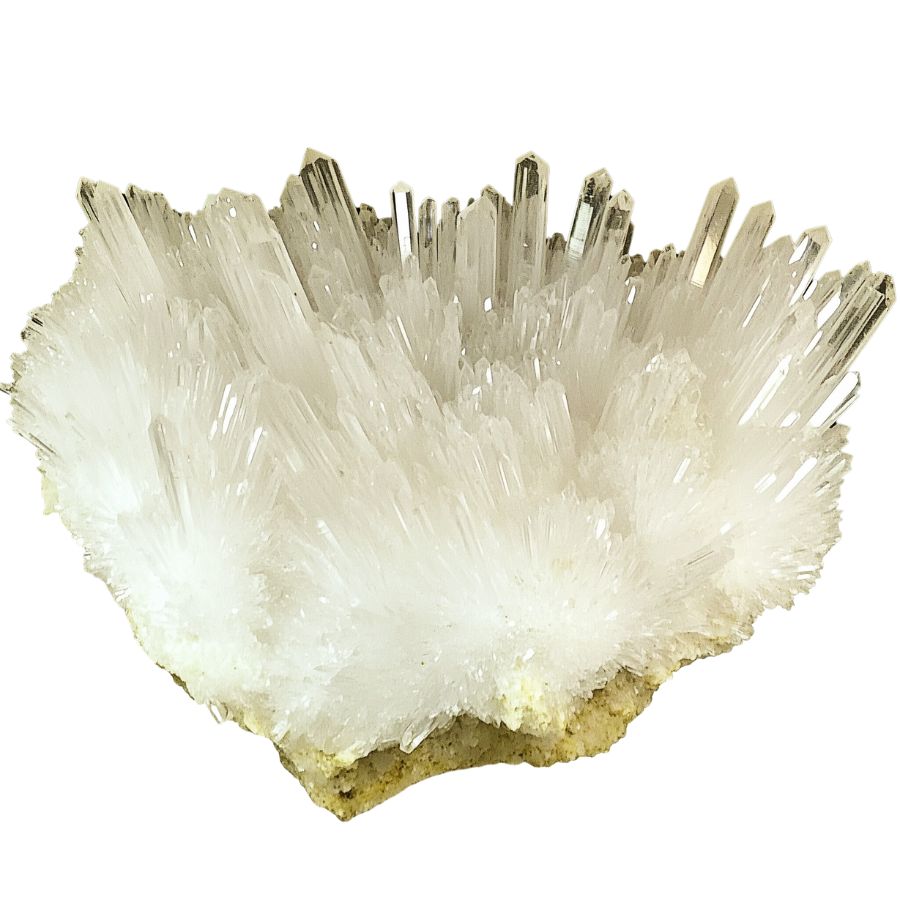
Scolecite geodes are like tiny crystal caves. They’re usually white or colorless, but sometimes you might find pink, yellow, or green ones.
What makes them special is the crystals inside. They look like thin needles or delicate hairs, all pointing out from the center.
These geodes are different from others because of their crystal shape. Instead of blocky or chunky crystals, scolecite has these fine, hair-like ones. This gives them a unique, delicate look.
Scolecite has an interesting property – it can hold a lot of water in its structure. This means it can absorb and release water easily. This makes scolecite useful in various ways, not just as a pretty rock to look at.
Apophyllite Geode
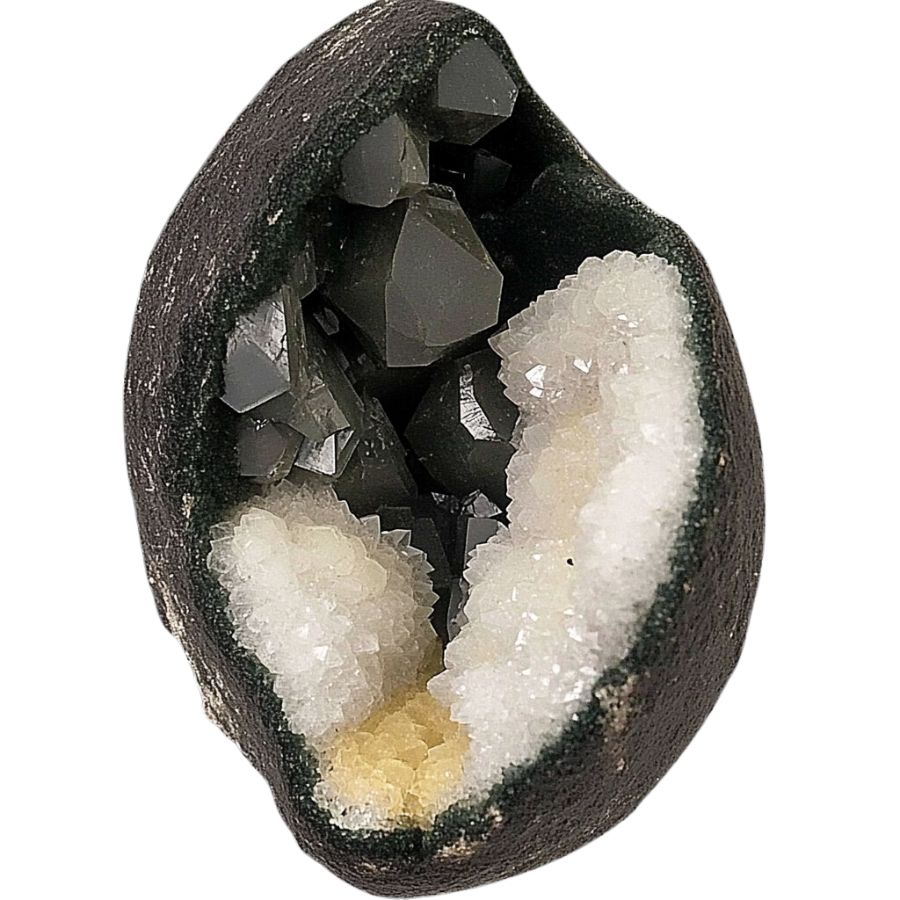
Apophyllite geodes are like nature’s disco balls. They often have dark or black crystals inside a hollow rock. These crystals can be see-through or slightly cloudy, with cube-like or flat shapes.
What makes apophyllite geodes stand out is how the crystals form. They grow in round clusters that look like tiny disco balls. This unique formation is rare and makes them special to rock enthusiasts.
Collectors really prize these “disco ball” clusters. They’re not common, which makes them valuable to people who love unusual rocks. The way apophyllite crystals catch and reflect light adds to their appeal, making them fascinating to look at and study.
What Rough Geode Looks Like
Identifying a rough geode might seem tricky, but with a few tips, you can spot one even if you’re not a rock expert. Here’s how you can do it.
Look for a Rounded Shape
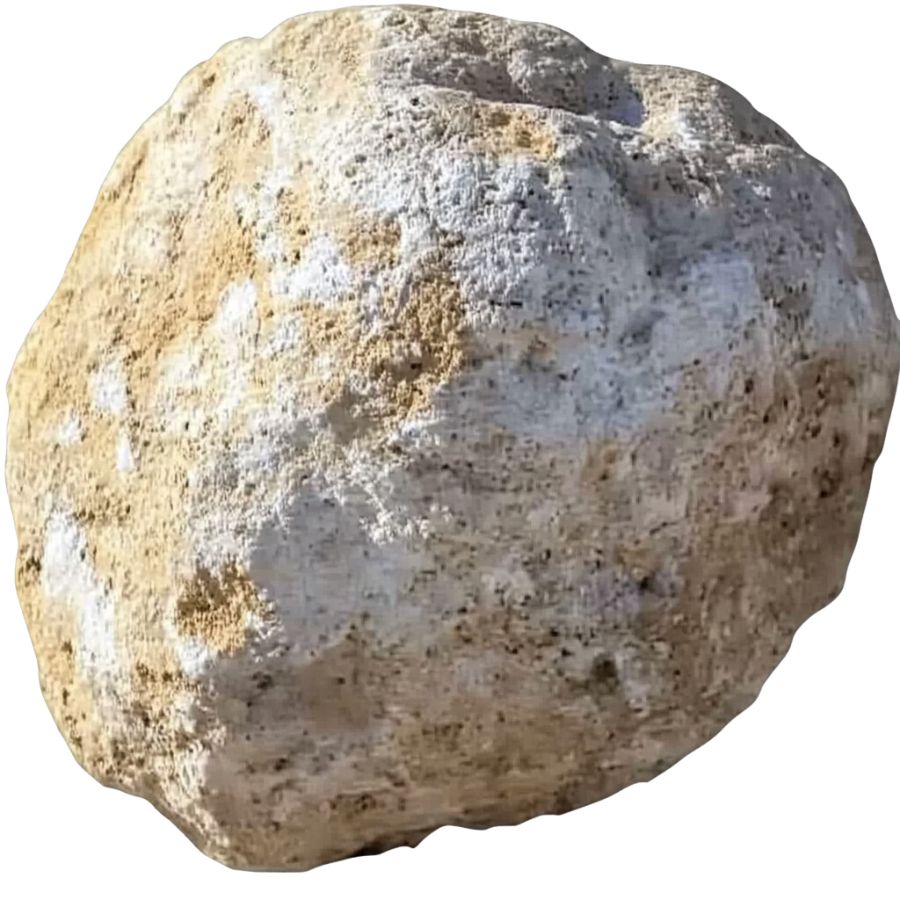
A rough geode often has a rounded or egg-like shape. It might not be perfectly round but look for a generally bulbous form.
When you’re out searching, skip the flat, jagged rocks. Geodes usually have smoother exteriors because they’ve been rolling around in rivers or other environments for a long time.
Check for a Dull, Bumpy Surface
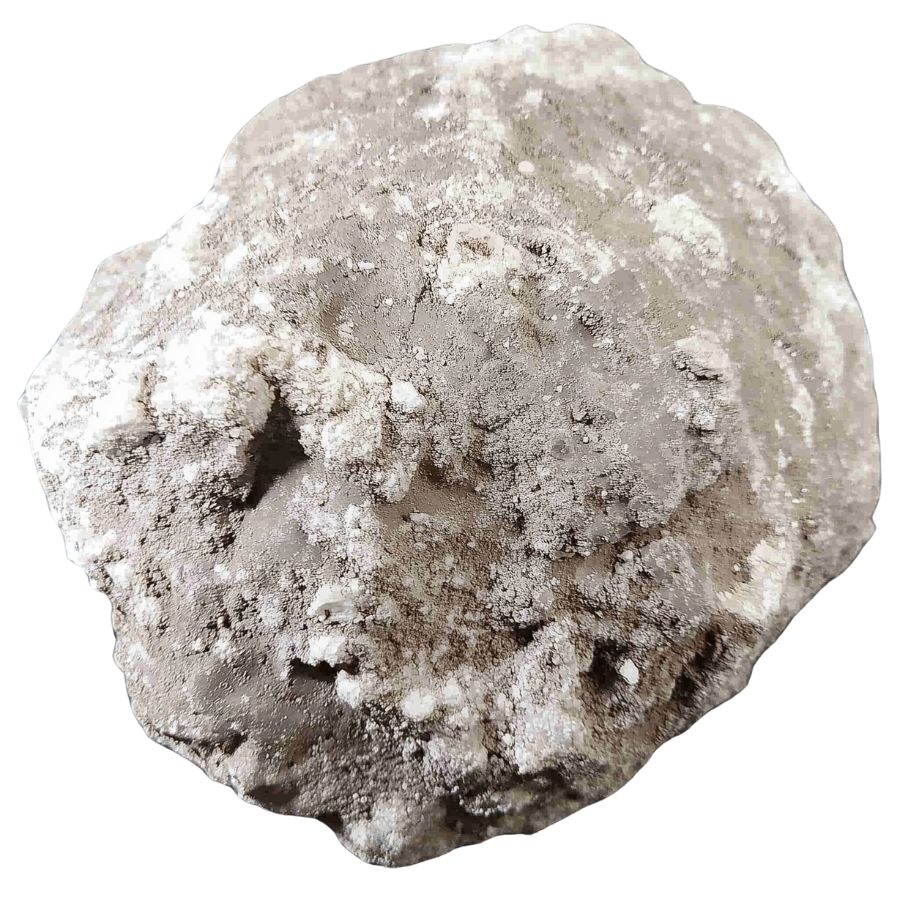
The outside of a geode isn’t usually shiny. Instead, it’s dull, bumpy, and a bit rough.
Imagine a potato or a clump of dirt with some bumps and dents. That’s how a geode might look before it’s cracked open.
The outside won’t give away much of what’s inside, so don’t be fooled by its ordinary appearance.
Test the Weight
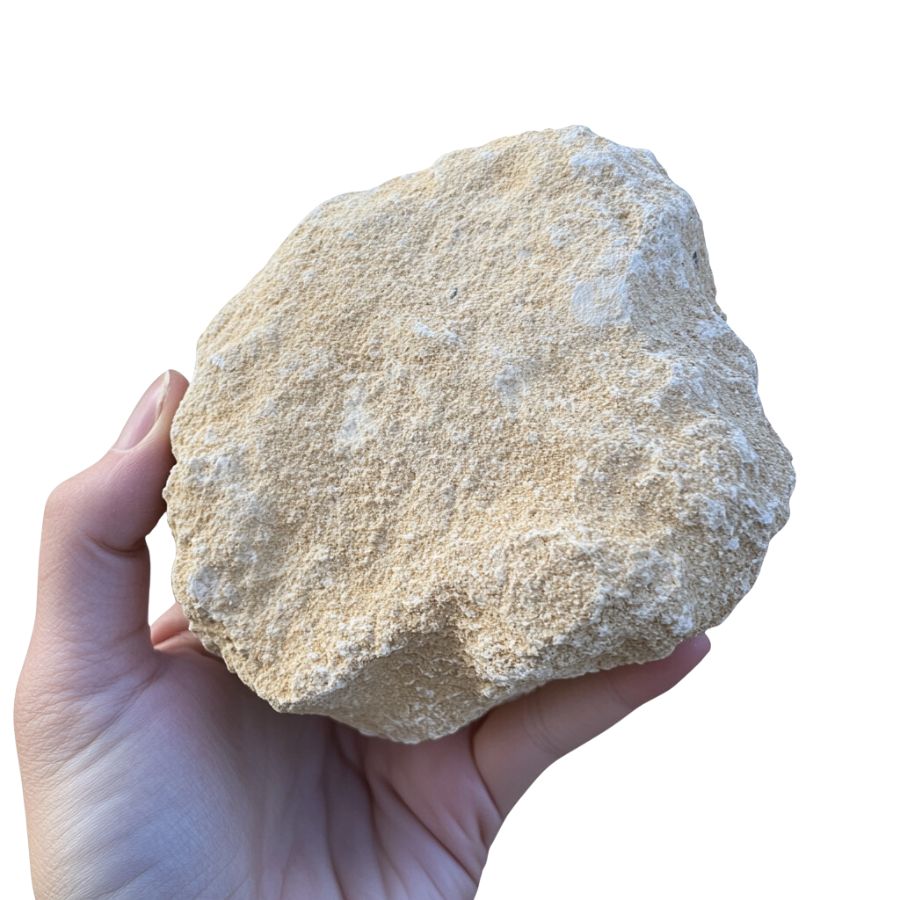
Pick up the rock. Does it feel lighter than it looks? That’s a good sign!
Geodes are hollow or partially hollow, which makes them lighter than solid rocks of the same size. If it feels unexpectedly light, you might have found something special.
Look for Tiny Crystals or Mineral Patches
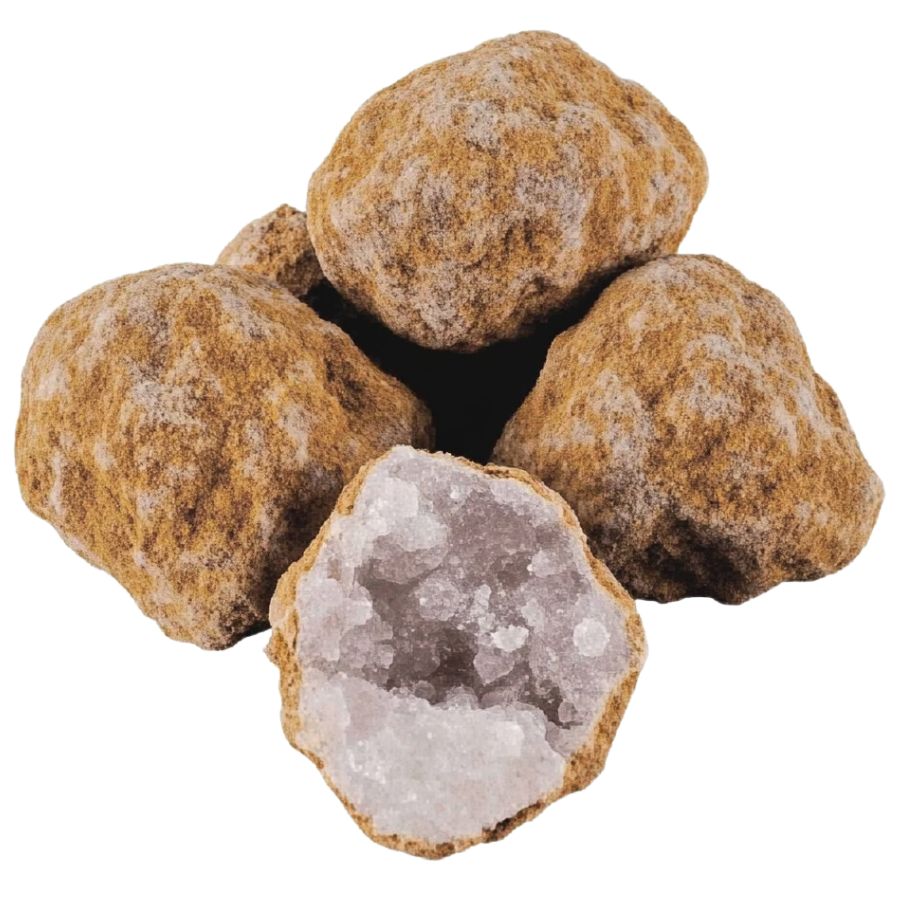
Sometimes, you can spot small crystals or mineral deposits on the outside. These could look like tiny sparkles or specks of color.
While the outside of a geode is usually dull, a little peek of what’s inside might show through. Keep an eye out for these hints, especially if you’re in a known geode-rich area.
Tips on Where to Look
Once you get to the places we have listed below there are some things you should keep in mind when you’re searching:
Explore Riverbeds and Streams
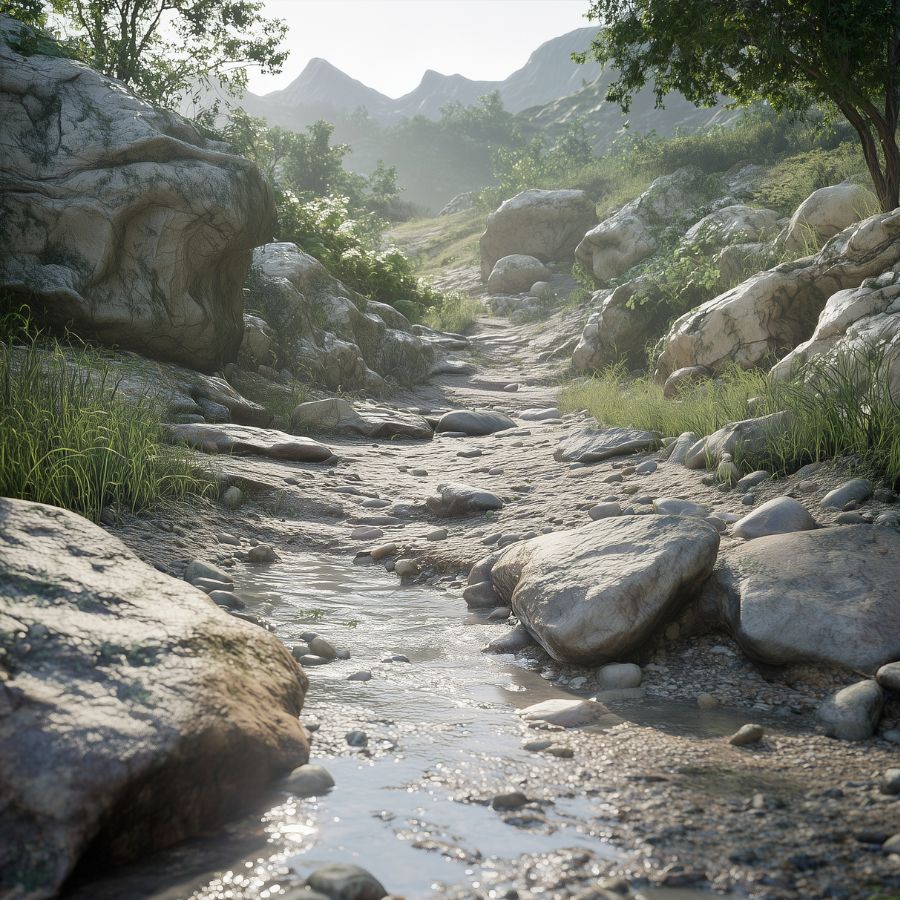
Geodes often form in riverbeds or streams. Water flow smooths out their rough edges and deposits them in these areas.
When exploring, focus on gravel bars or the edges of rivers where rocks naturally gather.
Search in Sedimentary Rock Layers
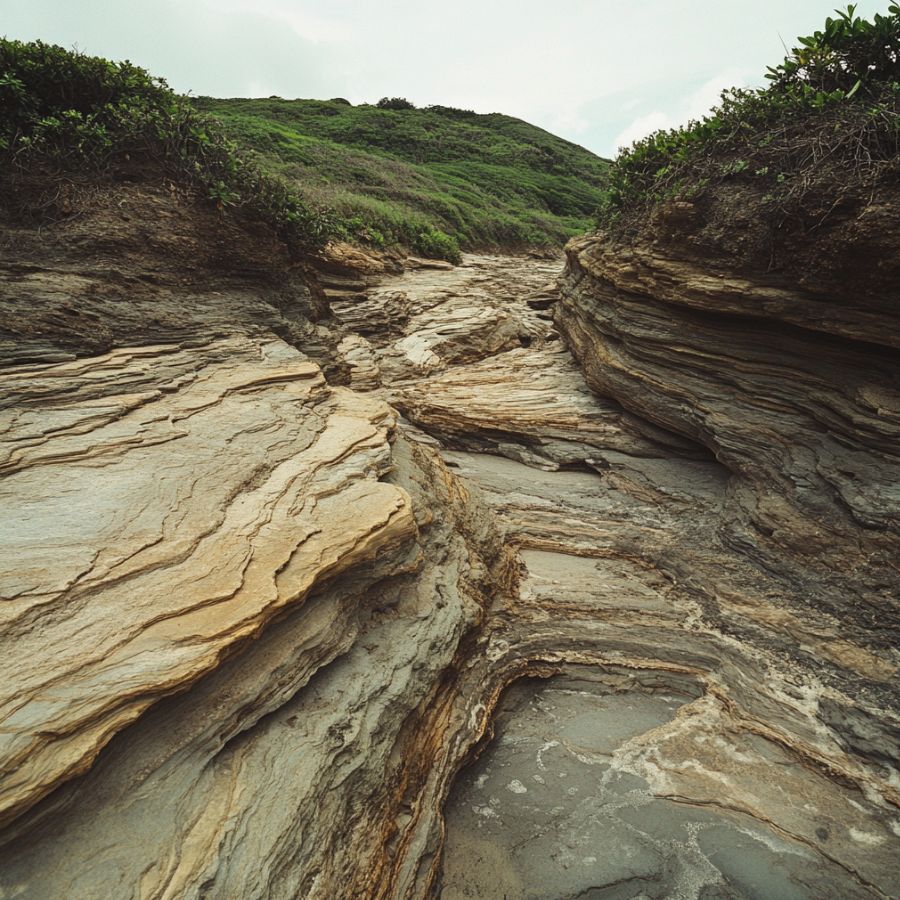
Sedimentary rocks, like limestone, are prime spots for geodes. These rocks form in layers over time, trapping minerals inside.
Look for areas where sedimentary rocks are exposed, such as cliffs or road cuts.
Visit Old Mines or Quarries
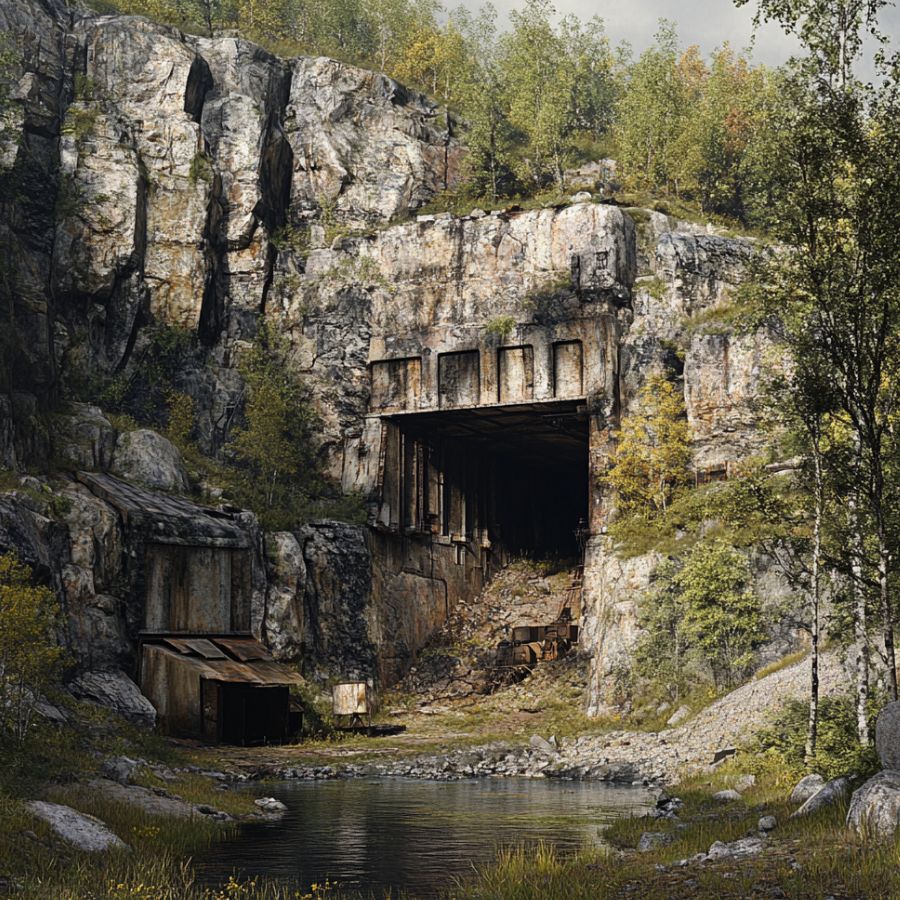
Abandoned mines and quarries are excellent spots for geode hunting.
Workers often missed geodes while digging for other materials. Explore the tailings or leftover rock piles for hidden treasures.
Explore Hills and Rock Outcrops
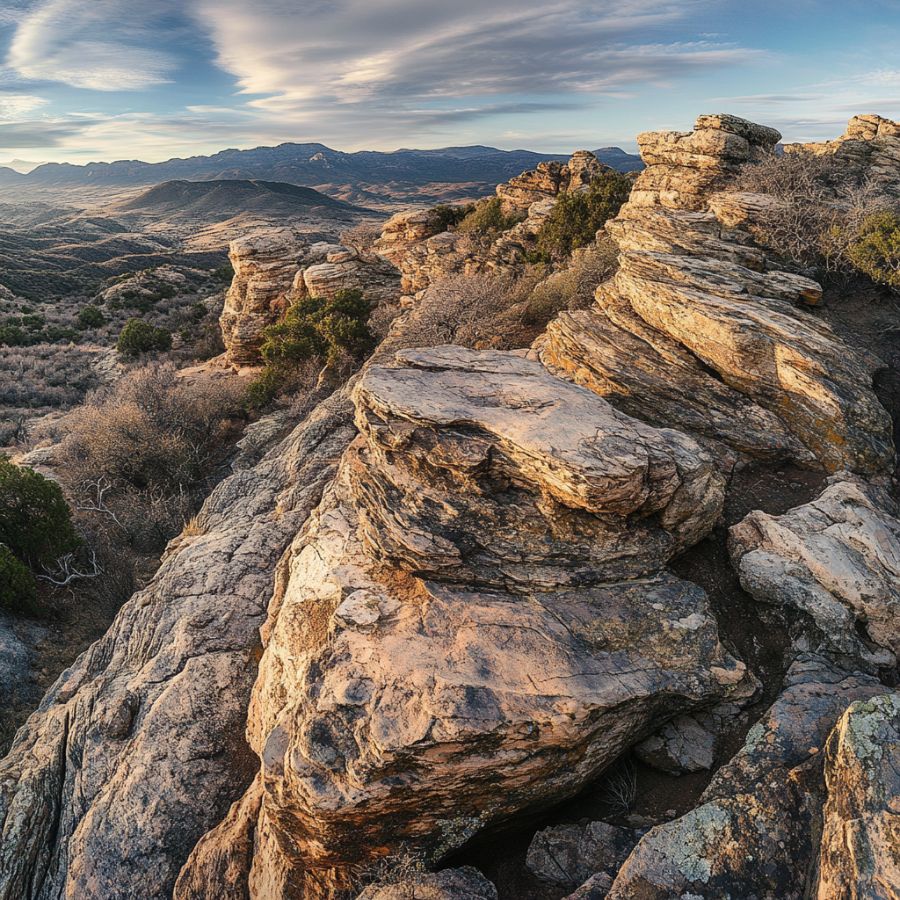
Hills and rocky outcrops often reveal geodes. As erosion wears away the softer rock, it exposes the harder geodes.
Look for areas with exposed rocks and keep an eye out for rounded shapes.
The Best Places To Find Geodes in South Carolina
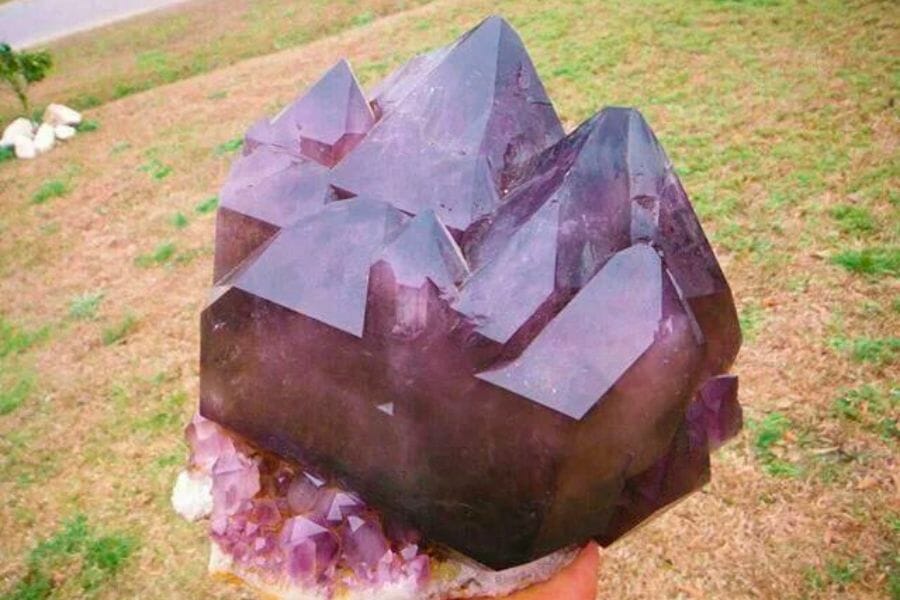
It’s common knowledge among rockhounds that South Carolina has some pretty amazing gem mines. So it might come as a surprise that geodes are very rare to find here— to the point that there’s no known spot where you can dig for them in their natural environment.
But if you’re keen on getting your hands on rocks and gems that are as stunning as geodes, we’ve got you covered with some of the best recommendations of places to explore! We even included here locations in nearby states where you can find geodes. Are you ready?
Always Confirm Access and Collection Rules!
Before heading out to any of the locations on our list you need to confirm access requirements and collection rules for both public and private locations directly with the location. We haven’t personally verified every location and the access requirements and collection rules often change without notice.
Many of the locations we mention will not allow collecting but are still great places for those who love to find beautiful rocks and minerals in the wild without keeping them. We also can’t guarantee you will find anything in these locations since they are constantly changing.
Always get updated information directly from the source ahead of time to ensure responsible rockhounding. If you want even more current options it’s always a good idea to contact local rock and mineral clubs and groups
Bowens River
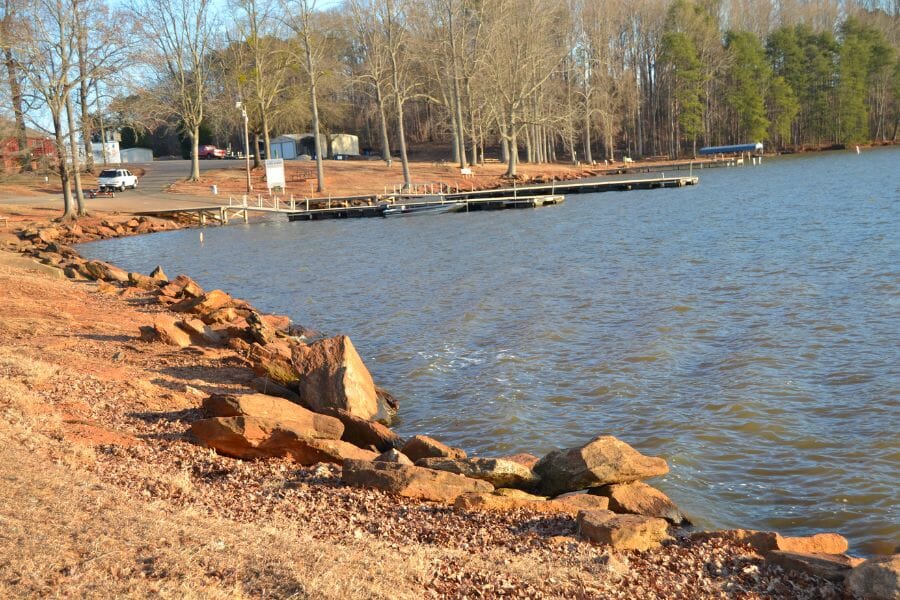
Bowens River runs through a swampy area with thick trees and undergrowth all around. It can be a bit tough to navigate, with lots of roots and rocks to trip you up, but it’s worth it when you get to the good spots.
As far as geology goes, this area is known for its Amethyst and Quartz crystals. It’s pretty cool to think that these rocks have been sitting here for millions of years, just waiting for someone to come along and find them.
One thing, though: getting here can be a bit tricky! You have to take some back road, park on the side of the road, and then hike your way. But it’s all worth it once you arrive. Before you visit, don’t forget to check the updated collecting guidelines of South Carolina.
Where we found geode-like formations
Bowens River is actually packed with LOTS of amazing gems that will fascinate you the same way geodes do. You can find Quartz, Amethyst, Emerald, and Sapphire when you explore the gravels and slate exposure of the river and its tributaries.
DON'T MISS OUT ON ANY GREAT FINDS!
While you're out searching for Geodes you're going to find a lot of other interesting rocks and minerals along the way. The last thing you want to do is toss out something really interesting or valuable. It can be easy to misidentify things without a little guidance.
We've put together a fantastic field guide that makes identifying 140 of the most interesting and valuable rocks and minerals you will find REALLY EASY. It's simple to use, really durable, and will allow you to identify just about any rock and mineral you come across. Make sure you bring it along on your hunt!
Myrtle Beach
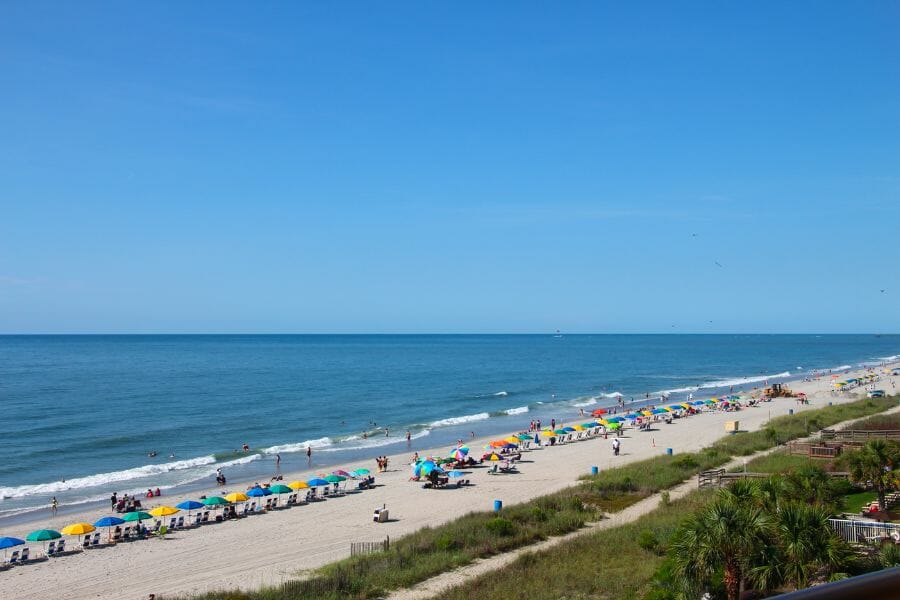
Chances are you’ve already heard, read, and seen photos of the beautiful and popular Myrtle Beach. This place is a real paradise with miles and miles of sandy beaches, crashing waves, and endless sunshine!
You might think this place is mostly just sand and seashells. But if you’re into collecting shells, this is where you want to be. You can find all sorts of cool specimens, from tiny coquinas to huge conch shells. And if you’re really lucky, you might even come across a shark tooth or two. You can also find amazing South Carolina crystals here if you search well enough.
To visit here, hop in your car and head east until you hit the ocean. There are plenty of hotels and restaurants in the area, so you can make a whole vacation out of it.
Where we found geode-like formations
While soaking under the warmth of the sun, you can find some amazing samples of Agate, Chalcedony, Megalodon teeth on the gravels and sands of Myrtle Beach.
Diamond Hill Mine
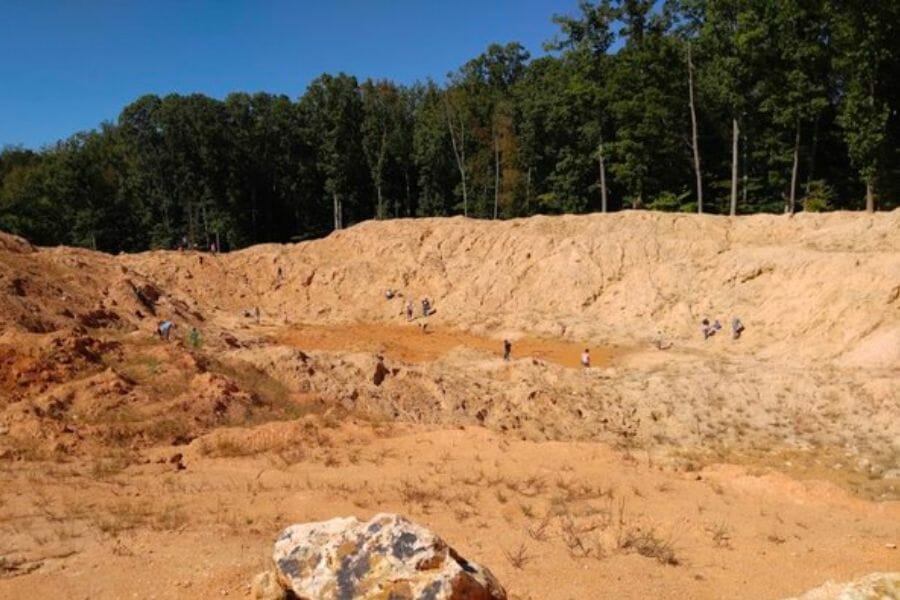
Diamond Hill Mine is a real treasure trove— like literally! It’s located in the rolling hills of western South Carolina, surrounded by lush forests and farmland. The mine is pretty rugged, with lots of steep hills and rocky outcroppings.
You’ll be blown away by the sheer variety of gemstones that are waiting to be discovered at the Diamond Hill Mine. The rocks here have also been around for millions of years, which adds to the beauty of the entire place.
Getting here can be a bit of a challenge, though. It’s off the beaten path and the roads can be pretty narrow and winding. But when you get here, you’ll understand why people love going here to dig for much sought-after gems and rocks.
Where we found geode-like formations
Being a mine, this location is pretty much loaded with astounding gems and rocks in all its different nooks and crannies. Make sure you take the time to explore here, and you might just be lucky to get your hands on some Amethyst, Quartz Crystals (Smoky Quartz), Beryl, Garnet, and Epidote.
Shooting Creek
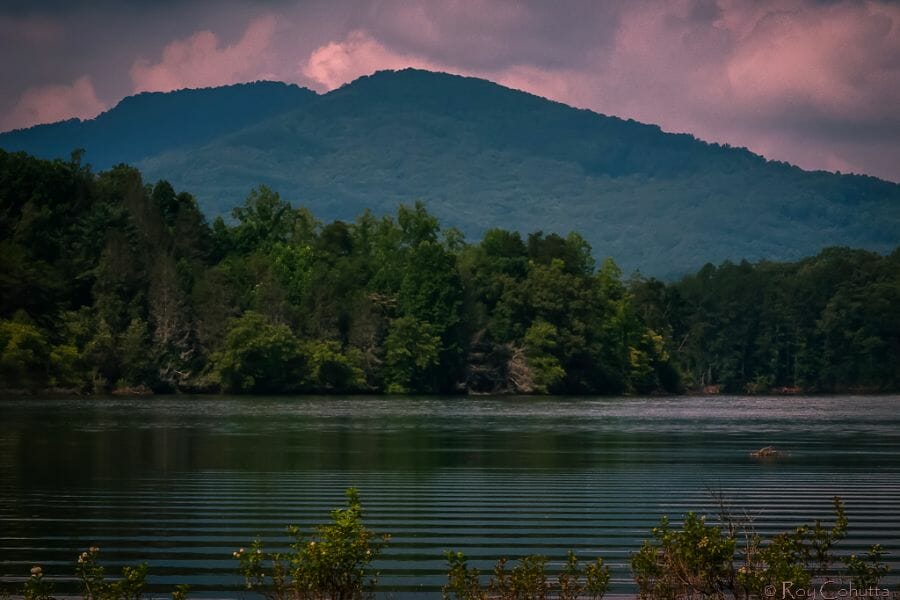
If you really want to find geodes and you’re willing to travel a little bit outside South Carolina, then Shooting Creek in North Carolina is your place to be! Luckily, North Carolina has great places where you can find geodes, and Shooting Creek is among them. It’s nestled in the mountains and is surrounded by dense forests and rocky terrain.
This place is kind of rugged, with lots of steep hills and winding streams. But what will really capture your attention is its stunning views and crystal-clear water. Looking around, there are some interesting rocks that greeneries that surround the creek.
If you intend on going here, make sure you’re up for quite a challenge. The roads around here can be pretty narrow and winding, but once you get here, you’ll be in for some treats from nature.
Where we found geodes at Shooting Creek
North Carolina boasts of having stunning Hyalite Opal geodes, which can only be found at the Shooting Creek. Amazing, right? If you want to find them, try exploring the creek’s area exposures, outcrops and gravels.
Emerson
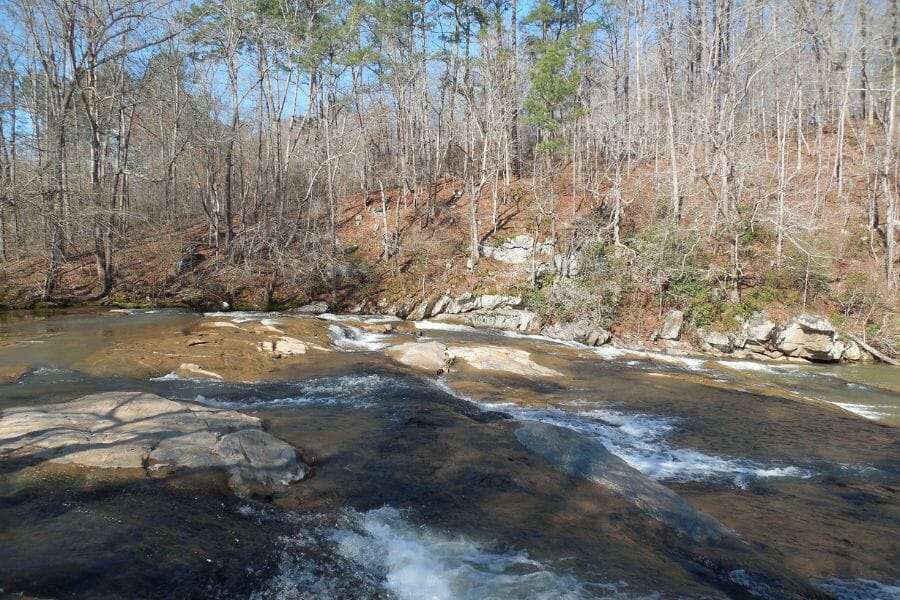
South Carolina’s other adjacent state, Georgia has amazing spots to find geodes, so we included here one of them. Emerson is located in the foothills of the Appalachian Mountains, surrounded by lush forests and rolling hills.
This area is pretty hilly but not too steep. And it has some unique geology that’s a mix of sedimentary and igneous rocks. You can find everything here— from Quartz and Amethyst to Agate, Jasper, and of course geodes!
This location is right off of I-75, so you can’t miss it. The road leading up to the mine is a little rough, but it’s nothing your car can’t handle. All in all, Emerson is definitely worth a visit.
Where we found geodes in Emerson
If you’re in Emerson, chances are you’re near a geode. Lucky for you, this place has some of the best geodes in the Georgia. To find them, explore the pits near US 41 bridge.
Common South Carolina Geode-Hunting Questions
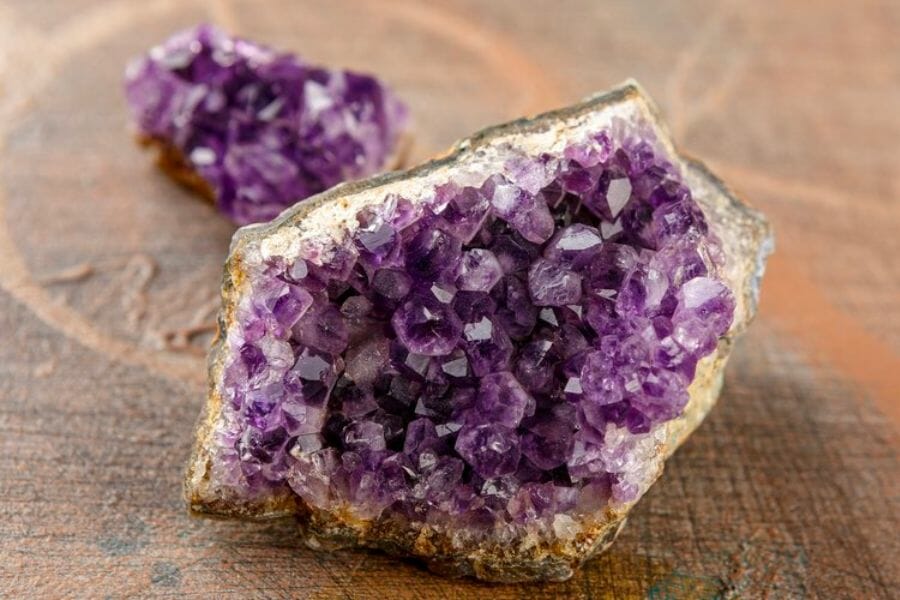
When planning to find geodes in South Carolina, people often ask the same common questions, so we made sure to answer them here:
Where can you find amethyst geodes in South Carolina?
Unfortunately, you won’t find naturally occurring Amethyst geodes here, but South Carolina has plenty of places where you can find some awesome Amethyst gems:
- Diamond Hill Mine in Abbeville County
- South of town on the McCalla farm in Lowndesville, Abbeville County
- On area float and in gravel pits of Herse Creek Valley in Aiken County
- Numerous exposures along Iva to Lake Secession in Anderson County
- Road cuts dike near lake of Anderson County
- On the W.T. Gibbons farm in Cherokee County
- On the numerous exposures, outcrops, fields of Greenwood County
- At Wrenn’s place in Greenwood County
- On area fields and cut banks of Shoals Juction in Greenwood County
- As float near Lake Greenwood in Greenwood County
- Dig in field to right of road in Laurens County
- At Lake Murray in Richland County
Is it illegal to collect geodes in South Carolina?
Just abide by the local rules and regulation in collecting and you’ll have no legal problems doing so here. Of course, make sure you double check any applicable local laws for government land and private lands, like obtaining necessary permits from offices and land owners.
The Best Places To Buy Geodes In South Carolina
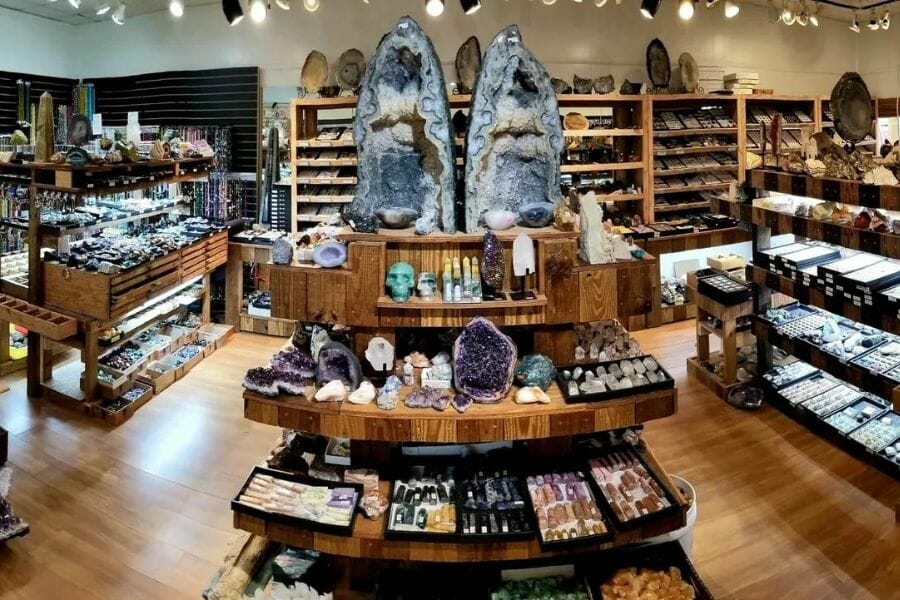
If you’re not eyeing to go out of South Carolina to get your hands on geodes, you may as well consider visiting the best local shops where you can find them here. Below is a list of stores that you can visit. They offer not only geodes, but also other equally fascinating rocks and gems.
- A & A Rock and Gem Shop – 1614, 1624 W Main St, Lexington, SC 29072
- Amazon – Would you believe there’s a great variety of geodes on Amazon? We’re surprised, too! You can even find complete kits to help you crack geodes open.
- Beckham’s Barn – 1751 Kennerly Rd, Irmo, SC 29063
- Spirit Crystals – 505 N Hickory St, Summerville, SC 29483
- Chimney Rock Gemstone Mine – 397 Main St Chimney Rock, NC 28720
- Swift Water – 3104 Rosewood Dr, Columbia, SC 29205
Additional places to find geodes in nearby states
Check out our guides for nearby states if you’ve already tried all of our suggestions above or if you’re planning a trip outside of the state:
If you have any recommendations for our list please leave a comment below!

